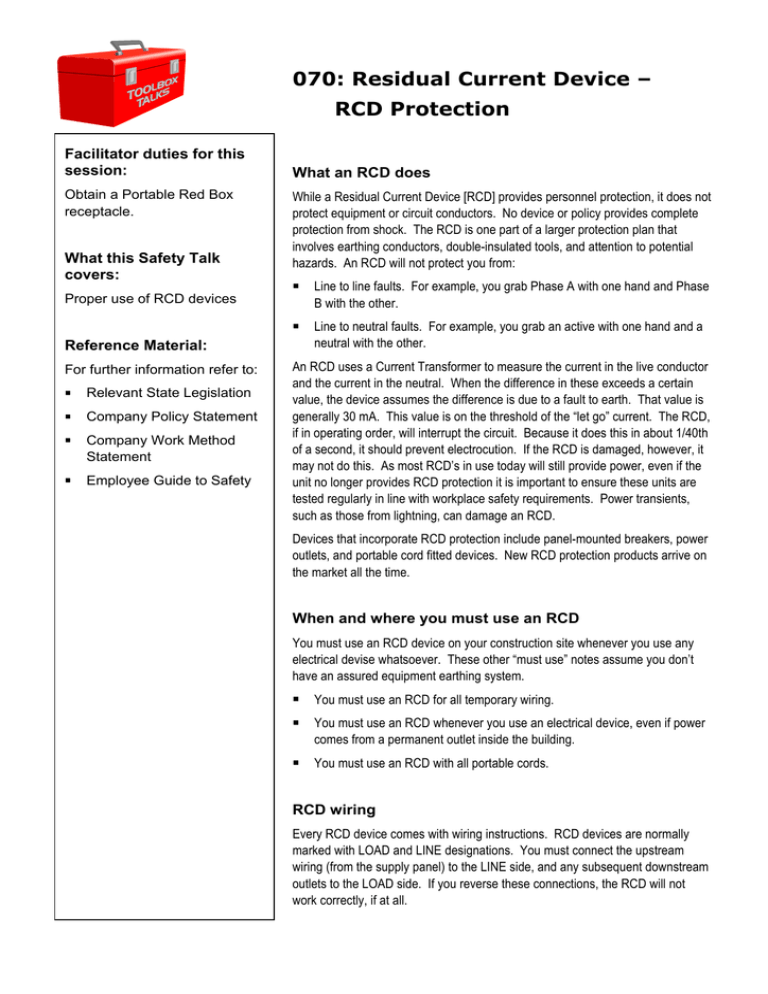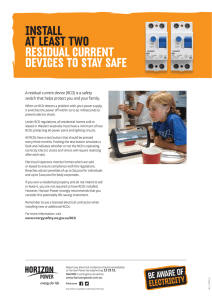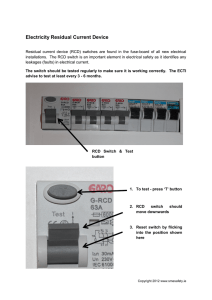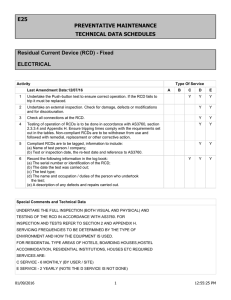
070: Residual Current Device –
RCD Protection
Facilitator duties for this
session:
Obtain a Portable Red Box
receptacle.
What this Safety Talk
covers:
Proper use of RCD devices
What an RCD does
While a Residual Current Device [RCD] provides personnel protection, it does not
protect equipment or circuit conductors. No device or policy provides complete
protection from shock. The RCD is one part of a larger protection plan that
involves earthing conductors, double-insulated tools, and attention to potential
hazards. An RCD will not protect you from:
Line to line faults. For example, you grab Phase A with one hand and Phase
B with the other.
Line to neutral faults. For example, you grab an active with one hand and a
Reference Material:
For further information refer to:
Relevant State Legislation
Company Policy Statement
Company Work Method
Statement
Employee Guide to Safety
neutral with the other.
An RCD uses a Current Transformer to measure the current in the live conductor
and the current in the neutral. When the difference in these exceeds a certain
value, the device assumes the difference is due to a fault to earth. That value is
generally 30 mA. This value is on the threshold of the “let go” current. The RCD,
if in operating order, will interrupt the circuit. Because it does this in about 1/40th
of a second, it should prevent electrocution. If the RCD is damaged, however, it
may not do this. As most RCD’s in use today will still provide power, even if the
unit no longer provides RCD protection it is important to ensure these units are
tested regularly in line with workplace safety requirements. Power transients,
such as those from lightning, can damage an RCD.
Devices that incorporate RCD protection include panel-mounted breakers, power
outlets, and portable cord fitted devices. New RCD protection products arrive on
the market all the time.
When and where you must use an RCD
You must use an RCD device on your construction site whenever you use any
electrical devise whatsoever. These other “must use” notes assume you don’t
have an assured equipment earthing system.
You must use an RCD for all temporary wiring.
You must use an RCD whenever you use an electrical device, even if power
comes from a permanent outlet inside the building.
You must use an RCD with all portable cords.
RCD wiring
Every RCD device comes with wiring instructions. RCD devices are normally
marked with LOAD and LINE designations. You must connect the upstream
wiring (from the supply panel) to the LINE side, and any subsequent downstream
outlets to the LOAD side. If you reverse these connections, the RCD will not
work correctly, if at all.
Review and Discussion
What will an RCD not protect
you against?
What does an RCD do?
When and where must you use
an RCD?
Proper connection of the active, neutral, and earth is critical. A common mistake
is connecting the earth wire to the neutral wire and the neutral wire to the earth.
Another mistake is swapping the live and neutral connections.
Remember, never earth the neutral at any point other than the MEN connection in
the fixed electrical installation. This will be only at one point (usually at the Main
Switchboard) where the neutral and earth are connected at the MEN connection.
Can an RCD provide power
even if it’s not providing
protection? What does this
mean?
How to ensure the RCD is protecting you
What must you do before first
use?
Don’t use a single-pole RCD unit on circuits that have more than one phase
circuits. Doing so simply prevents proper operation.
Does an RCD require an earth
wire for it to work?
If an RCD gives rise to nuisance trips, try replacing the unit. If the problem
persists, look for wiring errors or wiring damage.
What is the difference between
LOAD side and LINE side?
If an RCD trips, always test it before using it again
If an RCD trips, what should
you do before using it again?
Demonstration
What if an RCD nuisance trips?
Where can you not use a
single-pole RCD unit?
Always test the RCD before first use on a shift. To test it, push the “Test” button
to simulate an earth fault. Then, verify that the RCD has cut the power off. Push
the “Reset” button to check that it has restored power.
Have a crew member explain which terminal is for live load and which is for
neutral. Have another crew member demonstrate what to do before first use
each day.
Notes:
__________________________________________________________________________
__________________________________________________________________________
__________________________________________________________________________
__________________________________________________________________________
__________________________________________________________________________
__________________________________________________________________________
__________________________________________________________________________
__________________________________________________________________________
__________________________________________________________________________
__________________________________________________________________________
__________________________________________________________________________
__________________________________________________________________________
__________________________________________________________________________
__________________________________________________________________________
__________________________________________________________________________
__________________________________________________________________________
__________________________________________________________________________
__________________________________________________________________________
__________________________________________________________________________
© 2005 Electrical and Communications Association. All rights reserved
070: Residual Current Device –
RCD Protection
Review and Assessment
Participant Name:_____________________________________________
Please circle the correct answer to the following questions.
A Residual Current Device [RCD] provides personnel
protection, it does not protect equipment or circuit conductors.
True
False
No device or policy provides complete protection from shock.
True
False
An RCD will protect you from line to line faults.
True
False
An RCD will not protect you from line to neutral faults.
True
False
The RCD, if in correct operating order, will interrupt the circuit.
True
False
Power transients, such as those from lightning, can damage
an RCD.
True
False
Proper connection of the active, neutral, and earth is critical.
True
False
You do not need to always test the RCD before first use on
every shift.
True
False
If an RCD gives rise to nuisance trips, try replacing the unit.
If the problem persists, look for wiring errors or wiring damage.
True
False
Don’t use a single-pole RCD unit on circuits that have more
than one phase circuits. Doing so simply prevents
proper operation.
True
False
Participants Signature:__________________________ Date:__________
© 2005 National Electrical and Communications Association. All rights reserved
Toolbox Talks Register
1.
TOOLBOX TALK NUMBER / DETAILS
070: Residual Current Device – RCD Protection
Date: _________________
Session Leader / Trainer Name: ______________________________________________
Time Commenced: __________________ Time Completed: _______________________
Site / Project Location: _____________________________________________________
2.
PARTICIPANTS PRESENT
Name
3.
Signature
ISSUES ARISING FROM TALK
Session Leaders Sign Off: ______________________________________




